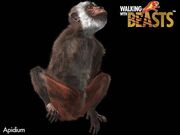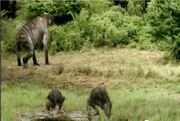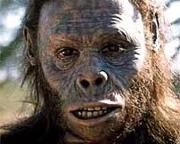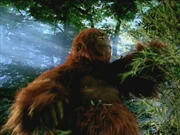
Godinotia.
A primate (i/ˈpraɪmeɪt/ PRY-mayt) is a mammal of the order Primates (i/praɪˈmeɪtiːz/ pry-MAY-teez; Latin: "prime, first rank").
Facts[]
In taxonomy, primates include prosimians and simians.
Primates arose from ancestors that lived in the trees of tropical forests; many primate characteristics represent adaptations to life in this challenging three-dimensional environment. Most primate species remain at least partly arboreal.
With the exception of humans, which inhabit every continent; most primates live in tropical or subtropical regions of the Americas, Africa and Asia.
They range in size from Madame Berthe's mouse lemur, which weighs only 30 g (1 oz), to the eastern lowland gorilla, weighing over 200 kg (440 lb). Based on fossil evidence, the earliest known true primates, represented by the genus Teilhardina, date to 55.8 MYA.
An early close primate relative known from abundant remains is the Late Paleocene Plesiadapis, circa 55–58 MYA.
Molecular clock studies suggest the primate branch may be even older, originating in the mid-Cretaceous period around 85 MYA.
The order Primates has traditionally been divided into two main groupings: prosimians and anthropoids (simians). Prosimians have characteristics more like those of the earliest primates, and include the lemurs of Madagascar, lorisoids, and tarsiers. Simians include monkeys, apes and hominins. More recently, taxonomists have preferred to split primates into the suborder Strepsirrhini, or wet-nosed primates, consisting of nontarsier prosimians, and the suborder Haplorhini, or dry-nosed primates, consisting of tarsiers and the simians. Simians are divided into two groups: catarrhine (narrow-nosed) monkeys and apes of Africa and southeastern Asia and platyrrhine ("flat-nosed") or New World monkeys of South and Central America. Catarrhines consist of Old World monkeys (such as baboons and macaques), gibbons and great apes; New World monkeys include the capuchin, howler and squirrel monkeys. Humans are the only extant catarrhines to have spread successfully outside of Africa, South Asia, and East Asia, although fossil evidence shows many other species were formerly present in Europe. New primate species are still being discovered. More than 25 species were taxonomically described in the decade of the 2000s and eleven have been described since 2010.
Considered generalist mammals, primates exhibit a wide range of characteristics. Some primates (including some great apes and baboons) are primarily terrestrial rather than arboreal, but all species possess adaptations for climbing trees. Locomotion techniques used include leaping from tree to tree, walking on two or four limbs, knuckle-walking, and swinging between branches of trees (brachiation). Primates are characterized by large brains relative to other mammals, as well as an increased reliance on stereoscopic vision at the expense of smell, the dominant sensory system in most mammals. These features are more developed in monkeys and apes and noticeably less so in lorises and lemurs. Three-color vision has developed in some primates. Most also have opposable thumbs and some have prehensile tails. Many species are sexually dimorphic; differences include body mass, canine tooth size, and coloration. Primates have slower rates of development than other similarly sized mammals and reach maturity later, but have longer lifespans. Depending on the species, adults may live in solitude, in mated pairs, or in groups of up to hundreds of members.
In Walking with... Series[]
Walking with Beasts[]
New Dawn[]
This episode features Godinotia - a small lemur-like mammal. Unlike the monkeys like Apidium, it was a primarily night-dwelling mammal (though it could be active during the day), and relatively solitary. It lived in trees, fed on Insects and only rarely came down to the ground. (In the book version it also hunted the winged Giant Ants that ate the Gastornis chick during the day.)
Whale Killer[]
This episode featured Apidium - a true monkey, not a lemur.

Apidium. (Official image.)
Unlike Godinotia it was a social, diurnal mammal that lived on mangroves, jumped from tree to tree, and was prey to local crocodiles and sharks.
Next of Kin[]
This episode was centered on a troop of Australopithecus. That particular troop was chased away by its rivals into a different, more open country, where they had to contend with giants like Deinotherium and hunters like Dinofelis.

Ancylotherium with Australopithecus
Initially prey to the large cat, at the end the australopithecines (under a new leader) rallied together and chased the Dinofelis away - but they still had a long time to evolve into humans.
Mammoth Journey[]
This episode featured two species of humans - the Neanderthal and the Cro-Magnon. Both species were well-adapted to live during the Ice Age, but the Neanderthals more so. The Cro-Magnons were more adaptable, however, and thus they were able to adapt once the Ice Age ended and the mega-fauna that characterized it dissappeared. The Nenaderthals did not and died out.
Walking with Cavemen[]
First Ancestors[]
This episode talked about the beginning of human evolution. It was centered around a group of australopithecines, including Lucy. These mammals were still apes, but they already walked on two feet as humans do - this allowed them to save some energy and to be better adapted to life on the ground, unlike the other primates, which walked on all fours at least some of the time. This episode ends with Lucy's death and the mention of her subsequent discovery in the modern times.
Blood Brothers[]
This episode depicted three of ancient apes and human ancestors: Paranthropus boisei,

Homo rudolfensis.
Homo Habilis and Homo rudolfensis. Paranthropus boisei was depicted as a gorilla-like ape that was well-specialized to the dry climate of the Pliocene with its nutcracker-like jaws, but died out as the climate and the ecosystem changed. Habilis and Rudolfensis were less specialized than Paranthropus was, but that lack of specialization allowed them to survive and to evolve into more modern species of ancient human.
Savage Family[]
This episode depicted Homo ergaster and Homo Erectus. Both species were much more human in appearance than their ancestors; they used tools made from stone and bamboo, but they still worked on instincts rather than intelligence. However, the end of the episode showed humans mastering fire, that allowed them to break free from the mold.
This episode also featured Gigantopithecus - the largest primate to ever walk the earth.

It scared away a group of Homo Erectus through its sheer size and power.
The Survivors[]
This episode depicted Homo heidelbergensis, the Neanderthals and the Cro-Magnons.

A NEANDERTHAL FROM WALKING WITH BEASTS.
Heidelbergensis was already very similar to modern humans, but they lacked imagination present in modern humans.
Then the species split into Neanderthals and Cro-Magnons. Similar to their depiction in Mammoth Journey (WWB), the Neanderthals were better adapted to the Ice Age environment than the Cro-Magnons were, but the Cro-Magnons were more imaginative; eventually they returned from Africa to Europe and took-over Europe and the rest of the world through their imagination. The less imaginative Neanderthal died out instead.
Evolution Game []
This WWB game was centered around Teilhardina belgica, a small primate from the Eocene epoch.
